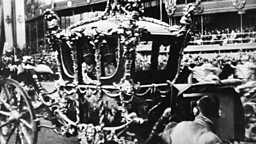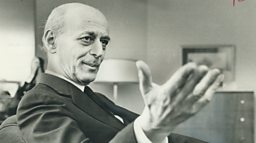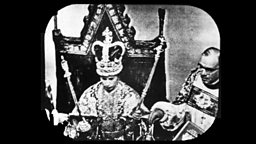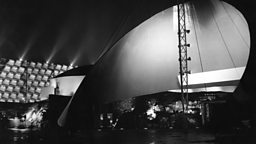Our Classical Century - History's Great Moments in Music
Our Classical Century, broadcast across ����ý TV and ����ý Radio 3, is a celebration of the most memorable musical moments from 1918 to 2018.
Part Two covers 1936 to 1953, a period of momentous events in the UK and worldwide, not least the cataclysm of World War II which changed society irrevocably, as had the Great War before it.
Beginning with music reflecting the pomp of a Coronation, here are five pieces of music which symbolise events of their time, from wartime resilience to postwar renewal.
All photos © ����ý
1. The Coronation of King George VI (12 May 1937)

Wednesday, 12 May 1937 was a grey day, heavy with clouds: a modest, apologetic kind of backdrop for the extraordinary and glittering events that were about to unfold. It was the day of the coronation of King George VI.
The weather may have been unremarkable; the scenery and the music were not. The pageant began at 8.45am, as the Royal Family and heads of state left Buckingham Palace for the gothic splendour of Westminster Abbey. Forty pieces of music were programmed for the day; 23 for the processional entries, and the rest for the service and afterwards.
Coronation favourites such as Handel's Zadok the Priest and Parry’s I Was Glad were performed alongside ceremonial moments from works by Elgar, Purcell, Howells: each attempting to out-fanfare the last. There were also five world premieres: music by Vaughan Williams, Bax, Bliss, Bantock, and William Walton, whose Crown Imperial was performed as Queen Mary and the Queen of Norway entered the Abbey.
Walton embraced both ceremony and setting in this seven-minute work, the triumphantly ascending strings pushing stiff punctuated rhythms up into the fan-vaulted ceiling of the Lady Chapel. One hundred feet below, an 11-year-old girl watched her mother and father become King and Queen of England. "I thought it all very, very wonderful," Elizabeth later wrote in a letter to her parents, "and I expect the Abbey did too. The arches and beams at the top were covered with a sort of haze of wonder as papa was crowned."
That "haze of wonder" spread far and wide across the country: busy roads fluttered with bunting while the smaller side streets were festooned with ribbons, garlands and crowns. Traffic was replaced with communal party tables crammed with children in Union Jack paper hats. The rain fell, but spirits were high: 12 May 1937 was a day when the whole of England momentarily became a theatre.
-
![]()
Listen to Walton's Crown Imperial
First performed at the coronation of King George VI in May 1937. This archive recording features the ����ý Concert Orchestra with conductor Barry Wordsworth.
2. The National Gallery Concerts in London (10 October 1939)

By 10 October 1939, the National Gallery in London was a shell. All of its paintings had been evacuated to Wales and Gloucestershire for safe-keeping during the war. The Government, worried about the potential for mass casualties if audiences congregated at night in concert halls and theatres, imposed a cultural blackout during the Blitz.
But just a couple of weeks into the war, the ����ý announced that the National Gallery would be opening its doors again between 1 and 2pm, five days a week. A plan for a series of wartime recitals had been proposed by the esteemed British pianist, Myra Hess.
Never had music seemed so important. Hess gave the first recital thinking that perhaps a few of her friends might turn up. But by ten to one, a thousand people were waiting outside. Once admitted, they sat on the floor for lack of chairs. And this went on. During air raid alerts, everyone would troop down to an underground shelter and the performances would be held there.
Not a single show was cancelled: in six-and-half-years, nearly 2,000 concerts were attended by more than 800,000 people. Myra Hess herself played in 150 of them; she liked to joke that she had never performed so much, yet practised so little.
One remarkable aspect was the amount of German music that was played. During the Great War, it had been forbidden to perform German song in the UK; it was considered the language of the enemy. But by the 1940s, that attitude had changed. Instead of boycotting German music, British artists championed it, recognising it as a culture too important to be tainted by the Nazis.
One of the great voices who graced the concert series at the National Gallery was the German mezzo-soprano Elena Gerhardt. Gerhardt arrived at the gallery, ashen-faced, to sing on the day that Germany invaded the Netherlands. She thought nobody would want to hear her, but the audience met her with a standing ovation.
-
![]()
Listen to Brahms's song, Feldeinsamkeit
How German music found a home in a remarkable wartime concert series in London. This archive recording excerpt features mezzo-soprano Elena Gerhardt (1883-1961) accompanied by pianist Coenraad V Bos (1875-1955).
3. The Edinburgh Festival (24 August 1947)

On 24 August 1947, the UK was two years out of war, its economy crippled. Rationing was still in place and European relationships were dismal. Circumstances could have hardly been worse for the opening of a new arts festival.
But the Edinburgh International Festival's founder, Rudolf Bing, knew that music could provide hope and unity even at the most broken of political times. It had taken him five years and some deft political haranguing, but by 1947 Bing had himself a festival.
The aim was explicitly internationalist and determinedly non-partisan. German, Austrian and Italian conductors and orchestras were invited for the very first edition, and the Jewish conductor Bruno Walter, who had been banned from working with the Vienna Philharmonic in the early 1940s, was reunited with them at the Usher Hall.
They opened the festival with Haydn's Symphony No 94, and gave intense performances of Beethoven's Pastoral, Schubert's Unfinished Symphony and Mahler’s Song of the Earth, with Peter Pears and Kathleen Ferrier as soloists. The city of Edinburgh was declared a "platform for the flowering of the human spirit".
-
![]()
Listen to Haydn's Symphony No.94, 'Surprise'
Music that opened the very first edition of the world's biggest arts festival. This archive recording features the ����ý Symphony Orchestra with conductor David Robertson.
4. The Queen's Coronation (2 June 1953)

On 2 June 1953, a little before 11.20am, a young woman in an exquisite, heavily embroidered dress stood with six maids of honour in the annexe to Westminster Abbey. "Ready, girls?" she reportedly said – and with that, 27-year-old Elizabeth joined the procession into the Abbey nave to be crowned Queen of the United Kingdom and Commonwealth states.
"I've seen one Coronation, and been the recipient in the other," she recently reflected, referring to the crowning of her father King George in 1937 when she was 11 years old. Composers William Walton and Arnold Bax were also experiencing their second Coronation. Following successful performances of their music at the 1937 ceremony, they had both been commissioned to write new works for Elizabeth.
Bax responded with an elegant march that seemed perfectly to capture what the Musical Times described as "the right atmosphere of dignity and confidence, of broad humanity and majesty". Walton’s Orb and Sceptre, meanwhile, positively swings. Cheerfully eschewing the sobriety of the occasion, it has swagger, vim – and it's kind of jazzy. It's tempting to think that the young queen had a little of that sassiness ringing in her ears as she stood in the annex in 1953 and stepped into history.
-
![]()
Listen to Walton's Orb and Sceptre
First performed at the coronation of Queen Elizabeth II in June 1953. This archive recording features the ����ý Philharmonic with conductor John Storgårds.
5. Festival of Britain (October 1953)

Elizabeth Maconchy's symphonic poem, Proud Thames, was first performed in the Royal Festival Hall in October 1953. The 2,900-seat concert hall had opened just two years previously, built as part of the Festival of Britain, which ran through the summer of 1951.
Although born in England, Elizabeth Maconchy (1907-1994) was of Irish descent and started to compose at the age of six. She studied at the Royal College of Music with Charles Wood and Vaughan Williams. At the college she had to struggle against the prevailing prejudice against women composers; she was denied the Mendelssohn scholarship on the grounds that once she was married she would cease composing and that, as a woman, she would not find a publisher.
However a different award enabled her to continue her studies in Prague with Karel Jirák, where her first major work, the Piano Concerto (1928) was performed. Far from giving up composing after her marriage to the medical historian William Lefanu (their second daughter is the composer Nicola Lefanu), her career steadily embraced all genres.
Maconchy made important contributions to British musical life, for example as the first woman chairman of the Composers’ Guild of Great Britain, and she succeeded Britten as President of the Society for the Promotion of New Music. She was made a CBE in 1977 and a DBE a decade later. She summed up her approach succinctly: ‘Writing music, like all creative art, is the impassioned pursuit of an idea.’
-
![]()
Listen to Maconchy's Proud Thames
A symphonic poem that received its premiere in a dazzling new concert hall for Britain. This archive recording features the ����ý Symphony Orchestra with conductor Michael Seal.
You can listen to all the clips from Our Classical Century here. The series is broadcast as part of Essential Classics on ����ý Radio 3.

-
![]()
Our Classical Century
A celebration of the most memorable musical moments from 1918 – 2018.
-
![]()
Time Travellers
1920s rap, space opera and classical composers accused of espionage: Essential Classics' Time Travellers explore music and inspired by Our Classical Century.
-
![]()
Five sensational pieces from 1918-36
An in-depth look at world-changing music from the beginning of Our Classical Century.
-
![]()
Essential Classics
Refresh your morning with a great selection of classical music, presented by Suzy Klein and Ian Skelly.







